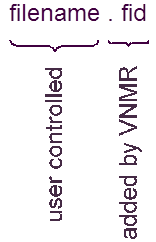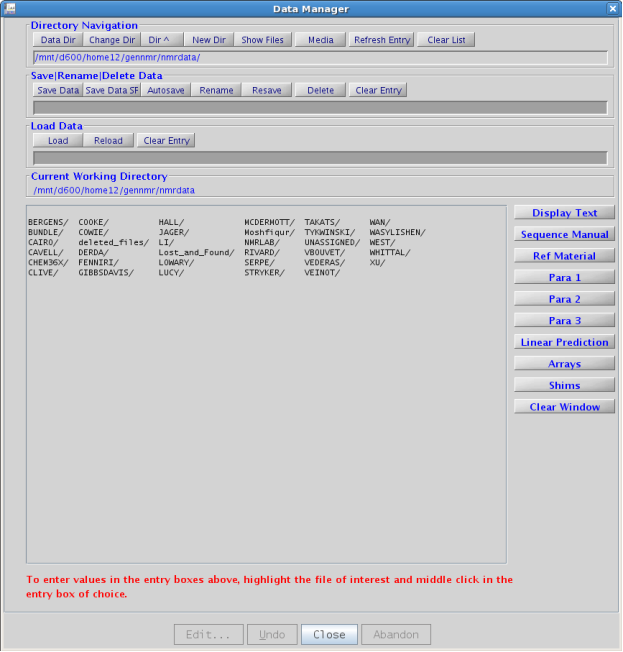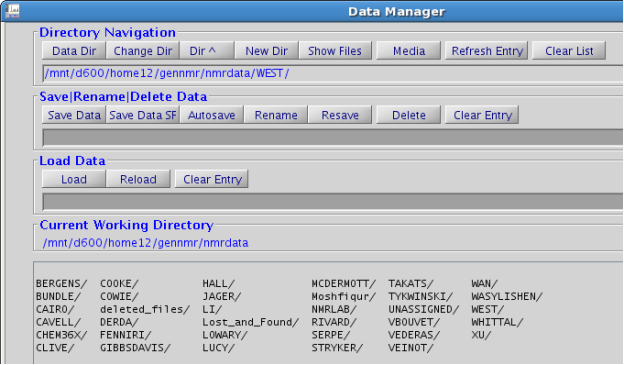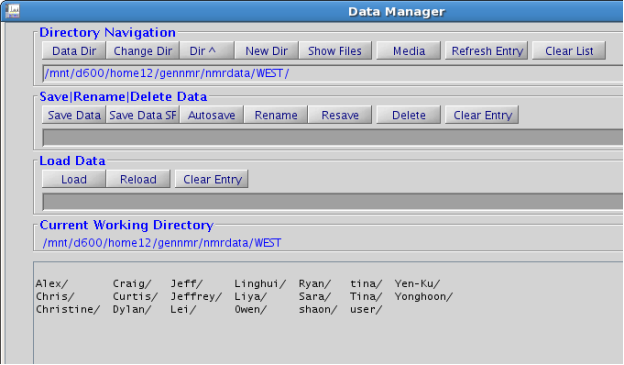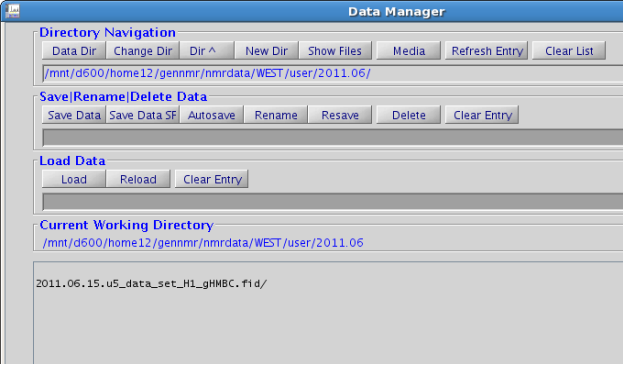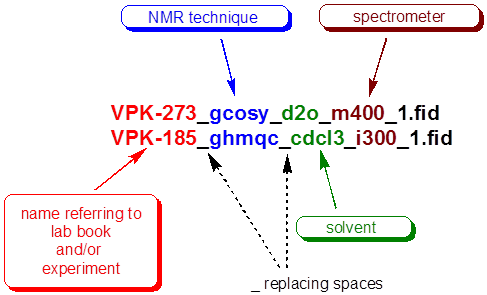7. Data and Data Management
Data from the acquisition computer are stored on the disk of the host computer every time a block (bs) is complete.
This file is of temporary nature.
If not saved by the user, the data are lost for good when another acquisition is started in the same experiment. There is no undo, undelete, or trash for data lost in this manner.
ALWAYS SAVE YOUR DATA. Data sets are cheap, in fact data are free and use recycled electrons for storage. Printed spectra are easily lost or damaged and re-synthesizing a compound can be expensive in both time and chemicals.
Always try to be explicit with experimental text, file names, directories. Finding data at the end of a degree will be much easier.
VNMRJ automatically creates a directory for every saved experiment:
The extension .fid is added automatically. |
|
|
Figure 7.35: VNMRJ file format |
Contents of filename.fid directory:
fid |
the actual data from the acquisition (FID), a binary file |
log |
a log file from the acquisition, may contain error messages, a text file |
procpar |
all acquisition, processing and display parameters, a text file |
text |
user entered description(s) of the sample and experiment, i.e. sample name, sample concentration, etc., a text file |
The file called procpar contains all acquisition, processing and display parameters. This means that whenever and wherever you access (load) the data again, they will look exactly as saved. It is advisable to adjust a spectrum in a way that is useful for future use. This can be done before saving and resaving the data.
Only data that are saved to disk and then read back will have the correct file name on printouts (otherwise the file name will be exp). This procedure serves as a test as to whether the data are were saved properly.
The Linux user account, gennmr, is cleaned out by the computer nightly, all files older than 180 days (gennmr) are automatically deleted. Users of the gennmr Linux user account are encouraged to archive their data regularly.
7.1 The Data Manager window
The Data Manager is an entirely in-house created window.
Many actions performed in the Data Manager window are based on Linux copy and paste functionality. Text that is highlighted (left click and drag) in Linux is automatically copied to the clip board and is available for pasting. Text can be pasted to the location of choice by simply clicking on the middle mouse button or scroll wheel.
|
Figure 7.36 : Starting the Data Manager |
|
Figure 7.37 : The Data Manager window |
When opened the Data Manager starts in the default data directory for your Linux user account. Shown above, the Data Manager opened in the gennmr user account starting in the default data directory for gennmr.
The usage of the Data Manager is best shown with an example, navigating to a user’s directory within the WEST directory of the gennmr user account.
To navigate to the WEST directory, highlight the WEST directory in the Data Manager window, as shown below.
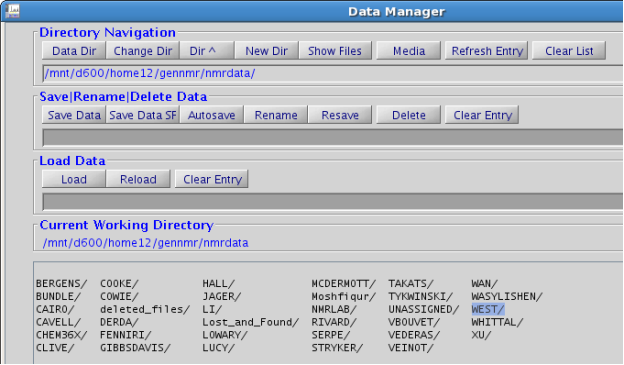 |
Figure 7.38 : Copy directory information for navigation |
Paste the directory WEST into the Directory Navigation text box, middle click the mouse at the end of the Directory Navigation text box, as shown below. Names can also be entered directly into the Data Manager’s various text boxes using the keyboard.
|
Figure 7.39: Paste directory information at the end of the Data Navigation text box for navigation |
Click on the button Change Dir to enter the WEST directory. The results are shown below.
|
Figure 7.40 : Navigating into the WEST directory |
The contents of the directory are shown after successfully changing directories. Repeat the steps outlined above until the desired directory is reached.
|
Figure 7.41 : The final directory is chosen |
Data can be loaded from the directory shown above by highlighting the desired file and pasting it in the text box Load Data and then clicking on the button Load.
Data can be saved to the location shown above by entering information in the text box Save|Rename|Delete Data and then clicking on either Save Data or Save Data SF buttons.
7.2 The Data Manager buttons
Directory Navigation
Data Dir: Go to default data directory for the user account.
Change Dir: Change to directory indicated in the text box Directory Navigation.
Dir ^: Go up one directory.
New Dir: Create directory indicated in the text box Directory Navigation.
Show Files: Show contents of current working directory.
Media: Go to media directory if CD, DVD, or USB key has been inserted in to the computer.
Refresh Entry: Refresh the Data Navigation text box.
Clear List: Clears the Data Manager window.
Save|Rename|Delete Data
Save Data: Save data in user defined format, free form. All spaces and special characters are replaced with an underscore _.
Data saved over many years of acquiring NMR and creating thousands of files, has led to the following recommended naming scheme:
|
Figure 7.42 : Suggested file name structure |
Save Data SF: Data are saved in a predefined format. The system will append a date stamp, machine stamp, transmitter nucleus, and pulse sequence to the sample name. Files saved in this format will lead to chronological directory content. All spaces and special characters are replaced by an underscore, _.
For example, Save Data SF will create the file name:
2011.06.15.u5_data_set_H1_gHMBC.fid
for a gHMBC recorded on June 15, 2011 on the u500 for the sample named data set. The text in red was entered in the Save|Rename|Delete Data text box by the user.
Autosave: automatically saves a running experiment in the currently joined experiment. Data are saved in the same manner as the button Save Data SF.
Rename: prompts user for new name on the VNMRJ command line for the file name entered in Save|Rename|Delete Data text box.
Resave: no entry required, resaves data loaded from disk in its original location and original file name.
Delete: deletes file(s) entered in Save|Rename|Delete Data field. More than one filename can be entered. All files must be separated by a space. Deleted data end up in the Linux user account’s trash for recycling when needed.
Clear Entry: Clear all entries in Save|Rename|Delete Data text box.
Load Data
Load: load data from filename entered in Load Data text box.
Reload: no entry required, data are reloaded from current file previously loaded from disk.
Clear Entry: Clear all entries in Load Data text box.
